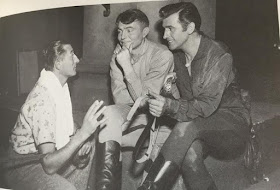 |
| Cover of John O'Hara's Hollywood, 2007. |
 |
| John O'Hara at work, circa 1960. He's looking you over to figure out which brand of shirt you're wearing and what that says about you. |
John O’Hara was one of the most successful American authors
of his generation. O’Hara rose to fame during the 1930’s through his short
stories in The New Yorker, and from
his first two novels, Appointment in
Samarra, and BUtterfield 8. O’Hara
spent varying amounts of time in Hollywood from 1934 to 1955 as a screenwriter,
and his time in California informed the short stories in the 2007 collection John O’Hara’s Hollywood. The book
collects all of O’Hara’s 22 stories about Hollywood and the movies. It’s an
excellent collection for fans of O’Hara’s writing, but it’s not without its
faults.
Most of O’Hara’s early short stories from the 1930’s and
1940’s were very short, with many being under 1,000 words. O’Hara was a master
at creating a mood in just a few words in these super short stories. O’Hara’s
stories don’t really have endings that resolve the story; they just suddenly come
to a halt. In this way, they capture the rhythm of real life.
Personally, I found the early short stories in John O’Hara’s Hollywood to be the most
interesting. I thought that some of his later stories from the 1960’s were just
too long and lacked narrative drive. The longest stories in the book are “Yucca
Knolls,” “James Francis and the Star,” and “Natica Jackson,” and those are the
three stories I found most disposable. They range from 50-80 pages in length,
and they’re overly reliant on dialogue. Not much happens in them, and it seems
that the only reason they are so long is just because they could be. O’Hara
also seems stuck in the past in these stories, as they re-hash the 1920’s and
1930’s, the decades which he was most comfortable writing about.
The last piece in the book is one of the most fascinating;
it’s a non-fiction piece titled “Hello Hollywood Goodbye,” that O’Hara wrote in
1968 for the magazine Holiday.
Unfortunately, the introduction doesn’t mention it at all, so we don’t get much
context for this piece. From what I know about O’Hara’s writings, it was fairly
unusual for him to write an autobiographical non-fiction essay.
John O’Hara’s
Hollywood was edited by Matthew J. Bruccoli, the leading scholar of John O’Hara
and F. Scott Fitzgerald. Bruccoli’s introduction is excellent, but someone in
the proof reading department was asleep at the wheel, as the introduction
states that F. Scott Fitzgerald wrote What
Makes Sammy Run? and The
Disenchanted, while Budd Schulberg wrote The Love of the Last Tycoon: A Western, when it’s actually the
other way around.
I noticed some interesting things as I read John O’Hara’s Hollywood, and one of them
is that O’Hara really had a thing for fake movie titles with the word “strange”
in them. In “The Magical Numbers” the fake biopic of President John Tyler is called
Strange President. (p.22) Strange Courage is the movie the actor
in “Adventure on the Set” has just finished. (p.27) Strange Virgin is the name of the movie that Kenyon Littlejohn is
making a test for in “Drawing Room B,” (p.49), and it’s also the name of the
movie, adapted from a novel, being made in “The Industry and the Professor.”
(p.62) I wondered if all these fake movies with “strange” in the title was supposed
to be an in-joke for movie fans. Were there a lot of movies with “strange” in
the title being made in the 1930’s and 1940’s?
O’Hara might be making some in-jokes as he re-uses some
character names in different stories. “The Answer Depends” name checks Sidney
Gainsborough, who appears in the first story in the book, “Mr. Sidney
Gainsborough: Quality Pictures.” The fictional actress Doris Arlington is
mentioned in “The Answer Depends,” “Yucca Knolls,” and “James Francis and the
Star.”
John O’Hara was a very interesting writer. He was clearly
gifted with superb and sensitive abilities to capture the way people talked,
thought, and felt, but yet in his personal life he had a knack for pissing off
nearly everyone he met. Of course, he’s not the only great writer who also had
a difficult personality. O’Hara had a keen sense of class and status in
America, and he had a large inferiority complex about having never attended
college. Ernest Hemingway supposedly once made the joke that he was collecting
funds to send O’Hara to Yale. The sad part is, O’Hara might have taken
Hemingway up on his offer. Obsessed with Yale life, O’Hara badgered the university
to give him an honorary degree. Yale declined, because O’Hara was graceless
enough to ask for the degree. O’Hara also made no secret of his desire to be
awarded the Nobel Prize in Literature. Of course, he never got it.
O’Hara finally quit drinking in the mid 1950’s, and he
became a much more prolific author, publishing 10 novels and 7 short story
collections between 1955 and his death in 1970. He became a famous and wealthy author,
and he gloried in the social signifiers that his status afforded him, as he
drove a Rolls-Royce and an MG convertible with his monogram on the door.
O’Hara still holds the record for the most short stories published
in The New Yorker, with an incredible
247! Along with those two other Johns, Cheever and Updike, O’Hara became synonymous
with The New Yorker and the
sophisticated short stories found between its covers.
At his best, John O’Hara was a superb chronicler of American
life and culture, and John O’Hara’s
Hollywood presents some of his best work.






